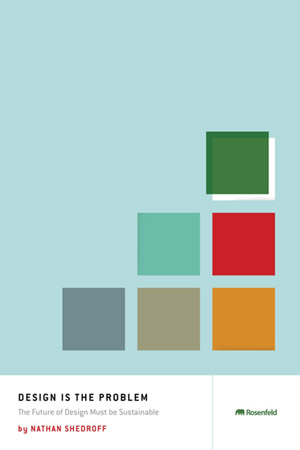


This post was submitted by guest contributor and author Nathan Shedroff [1]. In his upcoming book, Design is the Problem [2], Nathan explores one of the most interesting sustainable design strategies available to product developers.
Transmaterialization is a strange word, but the process is a new phenomenon not easily recognized by most people. Sometimes called ’servicizing‘ or ’product service systems,’ defined simply, it’s the process of turning a product into a service. Because this is often abstract and foreign to many people, the best way to explain it is in an example:
Consider how people bought music in the past. First, there were records, followed by tapes of different types (reels, 8-tracks, cassettes, and so on), and finally, starting in the 80s, compact discs (CDs). All of these are physical products, even though the music itself wasn’t necessarily physical. (It could already be transmitted across radio waves, for example.) Most people associated music with a physical object. Now, however, music is completely digital and even more virtual. The rise in music downloads (both legal and illegal) is displacing the sale of the physical CDs (though some, like records, will probably always be traded by collectors). In this way, the physical product has been displaced by a nonphysical service.

The best example of this is Apple's iTunes music store. Not only does the service enjoy 75 percent of the entire market for music downloads (and sells more music than any other company in the U.S.), but it is also no longer limited to music. The iTunes Music Store now sells films, television shows, applications (remember when those, too, were shipped on CD-ROMs?), and even books (as audio books). Where it would have once been unheard of to discuss these products as services once upon a time, we now regularly conceive and design new systems that do exactly this.
In the CD example above, one study1 of the life cycle analysis compared CDs bought in a store (do people even do this anymore?), to those bought online and shipped to a house, to music downloaded from the Internet directly. Of course, downloading music (or any service) still has an environmental impact (if only in powering the servers, hubs, and computers) but it is much less than the physical CD itself. Here’s proof:
In 2003, Digital Europe conducted a life cycle analysis of music CDs bought in stores, bought off Amazon and shipped to customers, and music downloaded off services like iTunes. Their study showed that all of these solutions had an impact of some kind. For example, music services require electricity to run services and lots of equipment to store, process, and transmit their data around the world. It’s not insignificant, either. However, even the demands of electronic data are a significant improvement over the demands of producing and distributing light-weight CDs and shipping them around the world.
| Scenario* | Abiotic impact (kg) | Biotic impact (kg) | Water use (kg) |
| CDs bought in physical store | 1.56 | 0.09 | 39.52 |
| CDs bought online, shipped to homes | 1.31 | 0.06 | 46.73 |
| Music downloaded (user burns CD-R) | 0.67 | 0 | 23.31 |
| Music downloaded (no CD-R copy) | 0.60 | 0 | 20.29 |
* Inclusion of computer materials impact is the same in each scenario
Services are often preferable to products because they focus on delivering consistent value while making more efficient use of products and resources. Consider how cars in rental firms or car share services are used more than privately owned cars that sit in parking lots and driveways most of the time. In addition, they’re usually better maintained. Services that replace purchased products outright can have the same efficiencies but they sometimes present a conceptual challenge to customers.

One example of where this has failed, though valiantly, is when the Atlanta, Georgia, floor covering company, Interface [3], tried to sell carpet as a service in the late 90s, Interface revolutionized the environmental impact of one of the worst industries in the world. (You should know that traditional carpet is terrible stuff, from an environmental perspective.) Interface changed everything about the materials and processes they used to make recyclable, less toxic carpet tiles that lasted longer, were better for workers as well as customers, and were taken back by the company when customers were finished with them.
However, when Interface took their ideas one step further and tried to reframe carpet from a product to a service (leasing floor coverings), they weren’t as successful. For the most part, business customers just couldn’t wrap their heads around the idea that they weren’t purchasing carpet, but they were leasing great-looking floors. Even though Interface guaranteed that they would maintain the carpet (including replacing damaged sections) and update, recycle, and dispose of it at their own expense, most people still couldn’t make the cognitive leap that they would be paying monthly for something they could otherwise buy outright—even if it represented an overall savings.
To transmaterialize solutions successfully, it's critical for developers to understand what makes a great service. Great service needs to do more than merely fulfill customer needs. Developers must understand customers' complete needs (often extending far beyond the transaction in both directions in time), and do so in culturally appropriate ways. Services build relationships, and when organizations aren't aware of this, poor relationships are usually the result.
As with products, a service's value must be framed in terms of customer benefit, not merely company benefit. Great service requires cooperation and coordination from all aspects of an organization (including IT, customer service, HR, senior management, product development, and operations). Customers’ needs must be understood not only in terms of price and performance (features), but also in terms of emotions, values, and meanings. All touch points must be coordinated so that the overall experience seems cohesive and consistent and this often requires coordination outside the organization to partners, suppliers, and other stakeholders in order to be successful.
Done correctly, services can provide better value and deeper connections than products while reducing impacts on natural, social, and financial capital. Transmaterialization offers the possibility of meeting our needs better and building deeper relationships with organizations, essentially creating more value and more meaning, while using resources more efficiently. This ’get more for less‘ approach should be at the heart of sustainable design and development and form the core of how we message to our customers and the rest of the world.
Design Is the Problem [4] is now on sale; Sustainable Minds readers can receive a 15% discount by using code SUSTMINDS when entering their purchase at the Rosenfeld Media site.
1. Source: The environmental and social impacts of digital music: A case study with EMI by Digital Europe [5]
Image credits (in order of appearance):
Rosenfeld Media
Apple Computer, Inc.
Interface, Inc.
Links:
[1] http://rosenfeldmedia.com/books/sustainable-design/author/biography
[2] http://www.rosenfeldmedia.com/books/sustainable-design
[3] http://www.interfaceinc.com
[4] http://rosenfeldmedia.com/books/sustainable-design
[5] http://www.forumforthefuture.org.uk/node/966